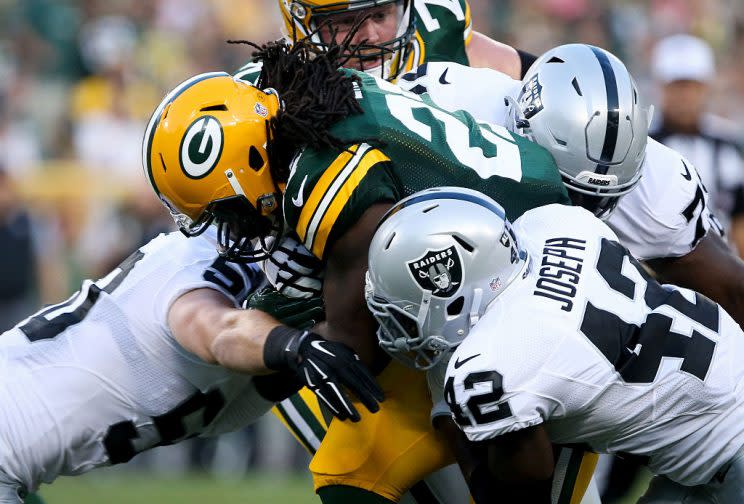Juggernaut Index, No. 3: The Green Bay Packers

The Juggernaut Index is our annual ranking and review of NFL teams for fantasy purposes — repeat: FANTASY PURPOSES. Here we concern ourselves with a franchise’s likely contributions to the fantasy player pool. We are not concerned with projected wins and losses. Instead, we’re focused on yards and points. As always, we’re beginning with the league’s least useful teams, working our way toward the elite fantasy juggernauts.
[Join a Yahoo Fantasy Football league for free and make 2016 your season!]
Aaron Rodgers is coming off arguably his worst season as Green Bay’s starting quarterback, as both his completion percentage (60.7) and yards-per-attempt (6.7) dipped well below his career averages. His passer rating fell below 100.0 for the first time since 2008. The fact that Rodgers still threw 31 touchdown passes and only eight interceptions in his worst professional season is a testament to his position among the all-time greats. He remains the NFL’s career leader in passer rating (104.1) and interception percentage (1.6), and he ranks fifth in Y/A (8.0). Among pure passers, he’s as good as it gets — as good as anyone has ever been.
We have to consider Rodgers’ slip in efficiency last season to be, in large part, a reflection of the remarkably poor performance by his receivers. Jordy Nelson’s preseason ACL injury removed a 1500-yard receiver from the equation, and no player on the roster — really, no three players on the roster — were able to adequately replace his production. James Jones, Davante Adams and Ty Montgomery combined for 115 catches, 1509 receiving yards and 11 touchdowns on 211 targets last season, with Jones doing most of the heavy lifting (50-890-8). The year prior, Nelson by himself delivered 98 receptions for 1519 yards and 13 spikes on just 151 looks.
Adams in particular was an on-field comedy last season, making the absolute least of a huge opportunity. He caught only 50 balls on 93 targets, gaining just 483 yards and visiting the end-zone once. Dropped passes were routine, and it’s a problem that’s dogged him in camp and preseason this year, too. This should go without saying, but Adams is not a recommended fantasy flier. Jones is a free agent as of this writing, recently cut by the Chargers. Montgomery is buried on the depth chart. Playoff legend Jeff Janis is dealing with a broken hand, and thus undraftable in leagues of standard size. Former Wisconsin Badgers receiver Jared Abbrederis made some noise in camp, but he’s a player with limited tools, still apparently behind Adams in Green Bay’s receiving hierarchy.
So it really comes down to this: Jordy Nelson and Randall Cobb need to remain fully functional in order for this team’s offense to meet the lofty expectations of NFL fans and fantasy owners. Cobb took a huge backward step in production last year, while dealing with both increased focus from opposing defenses and, perhaps more significantly, the season-long effects of an August shoulder injury. Based on Cobb’s history and his setup, however, it’s tough not to like him at his ADP (43.6). Nelson carries a loftier price (23.7) and he’s been sidelined for much of the summer with tendinitis in his non-surgically repaired knee. So yes, he carries some risk. But he returned to full practice recently, which is no small thing. If you can snag him near the end of Round 2 or top of Round 3, I’m not opposed.

Green Bay added tight end Jared Cook to the mix, enabling him to enter a season as a fantasy sleeper for the fifth time in his eight-year career, an unprecedented achievement. Kudos, Jared. Without question, Aaron Rodgers is the best quarterback that Cook has ever been paired with, by orders of magnitude. I won’t deny his sleeper appeal in 2016. Cook certainly wouldn’t be the worst player that Rodgers has carried to fantasy relevance. As a late-round target for those who pass on luxury tight ends, I like him. However, I would not draft him in a format so deep that I couldn’t easily replace him from the free agent pool. Richard Rodgers had several nice moments last season during his eight-TD campaign — none nicer than this — but he now finds himself behind Cook on the depth chart. Rodgers is probably a red-zone-only weapon at the moment.
Eddie Lacy struggled with girth last year, eventually falling into a job-share with James Starks. Lacy reportedly entered camp this season at a size that better suits the demands of his position, and he had some nice moments in the preseason, gaining 114 yards on 20 carries over three games. It’s tough not to like him in the third round of fantasy drafts. We can’t just ignore his terrific first and second NFL seasons, when he delivered 1400 scrimmage yards and double-digit TDs each year. Eddie is entering the final season of his deal, for those who care about such things. I’ve drafted him in multiple leagues in recent weeks, because the history is promising and he remains the featured back in an elite offense. Starks will no doubt have a role, but we can assume the early workload tilts toward Lacy.
The Packers D is nothin’ special, despite various brand-name players. But this team’s early-season schedule should be loaded with turnovers, so I’m interested in this group for fantasy purposes. Green Bay opens with Jacksonville (Bortles!), then Minnesota (Hill!/Bradford!). It’s a promising short-term setup, though it seems unwise to get too attached to this D/ST. It’s not an every-week fantasy asset.
—
2015 Offensive Stats & Ranks
Points per game – 23.0 (15)
Pass YPG – 218.9 (25)
Rush YPG – 115.6 (12)
Yards per play – 5.1 (28)
Plays per game – 66.2 (9)
—
Previous Juggernaut Index entries: 32) Cleveland, 31) San Francisco, 30) Philadelphia, 29) Baltimore, 28) Tennessee, 27) Los Angeles, 26) Miami, 25) Detroit, 24) Chicago, 23) San Diego, 22) Minnesota, 21) Tampa Bay, 20) Atlanta, 19) Washington, 18) Buffalo, 17) Kansas City, 16) Oakland, 15) NY Giants, 14) Indianapolis, 13) Jacksonville, 12) Houston, 11) Denver, 10) NY Jets, 9) Dallas, 8) Cincinnati, 7) New England 6) New Orleans, 5) Seattle, 4) Carolina, 3) Green Bay



